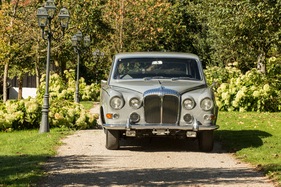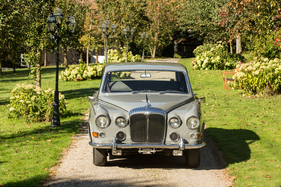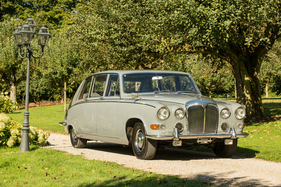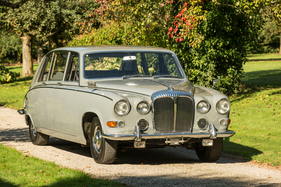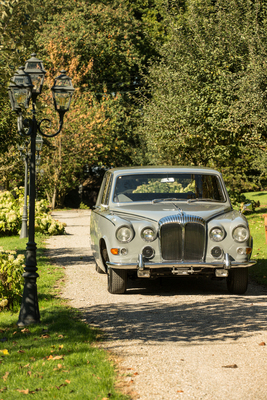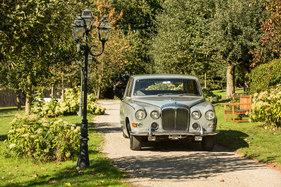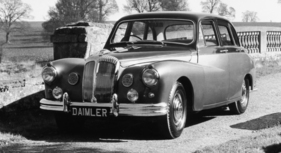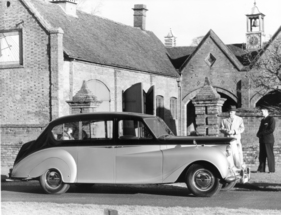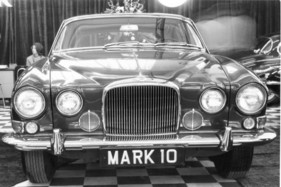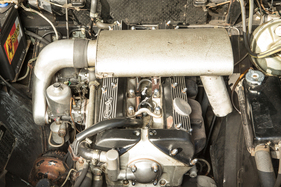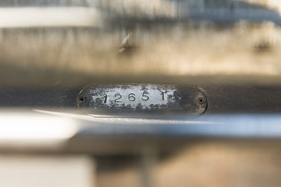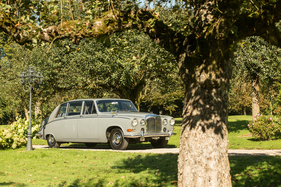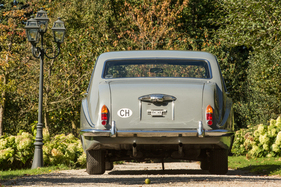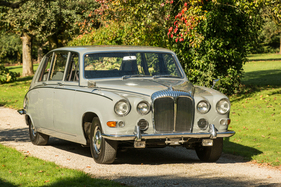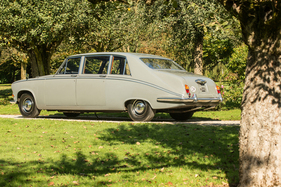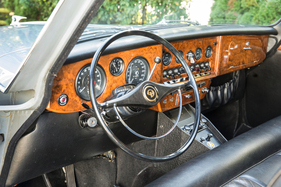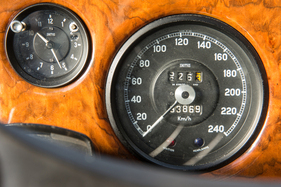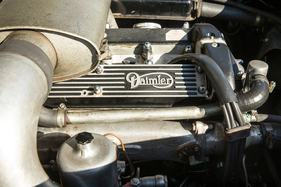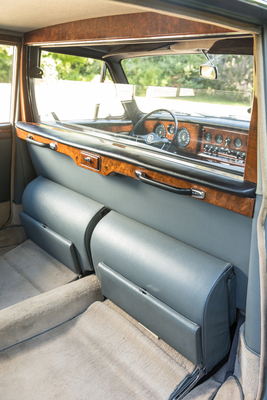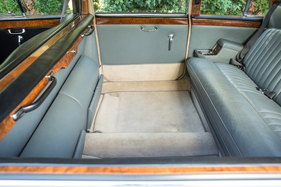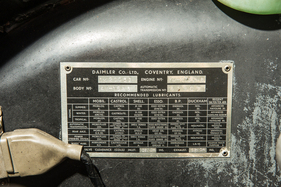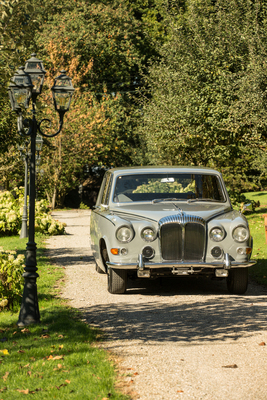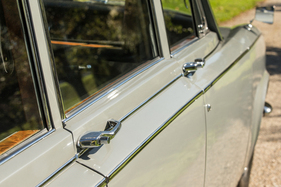In 1960, founder and owner Sir William Lyons took over Daimler - together with Lanchester - from the BSA Group as part of his expansion drive. The former supplier to the court had got into difficulties in the 1950s with extravagances and in some cases more than questionable exploits. However, Daimler had a valid arrow in its quiver with the engines of the former inventor of the classic British parallel twin for motorcycles, Edward Turner - in addition to the factory in Radford, whose additional capacity was targeted by the up-and-coming Jaguar company. In 1966, BMC, the British Motor Corporation, bought Jaguar and all its brands. This also included, for example, the forklift truck, installation, industrial and racing engine manufacturer Coventry Climax, but that is another story.
The Daimler Majestic Major was part of the Jaguar and Daimler portfolio at the time. A large limousine for self-drivers and chauffeur services, ministers and public figures. At BMC, on the other hand, the Vanden Plas Princess was in direct competition with the Daimler in the same market niche. In contrast to most volume models, which cannibalized each other within the brand network, this fact was taken into account at the top of the BMC Group. Both models were to be replaced by a single, state-of-the-art model.
Re- or upcycling
The leading force behind the project was Jaguar. Here, the decision was made to rely on familiar technology - and to amortize investments. The floor assembly of the new saloon came from the Jaguar Mk 10, which was extended by over 53 centimetres.
After Jaguar itself had cut off the Mark Ten with the launch of the "S", the largest production saloon from the UK at the time had to suffer significant sales losses in favor of the smaller, more agile and technically equal "S" after a few successful launches, at least the outlay for it could be amortized somewhat with the saloon project, if this was still an issue at all at the time. Although the Mk 10 or, as it was then called, the 420G was discontinued in 1968 with a view to the Jaguar XJ, the largest Jaguar ever built lived on, at least in part, with the Daimler DS 420 saloon presented in June - for a very long time indeed!
The Daimler was powered by the tried-and-tested XK engine with a displacement of 4.2 liters. This was coupled to a 3-speed Borg-Warner automatic transmission. The bodywork was made using pressed parts from Motor Panels Coventry, while the assembly work itself was carried out at Vanden Plas in Kingsbury, north-west London, where the individual components were delivered.
This method of production was to be maintained until 1979, despite constantly rising costs, after which Jaguar manufactured the car in its own small hall, the "Linousine Plant" on the grounds of the factory on Browns Lane in Coventry. Throughout all the years of production, the process involved a great deal of craftsmanship and assembly was never carried out on an assembly line, but statically.
For nobility and elite
With the Daimler, Jaguar, or rather the parent company British Leyland, under whose umbrella the brand was located from 1968, created a unique success. Admittedly, the market for such a vehicle was not infinitely large, but there was indeed a need for a prestigious vehicle that did not necessarily have the unchallenged luxury standards of a Rolls-Royce. like a Rolls-Royce, a Bentley or - to look beyond the United Kingdom - a Mercedes 600 or a Cadillac or Lincoln.
No fewer than eight crowned heads were among the Daimler's customers, but numerous limousine services also ordered such a vehicle. In addition to its prestigious value, the car also offered up to 8 seats in style, unlike a delivery van.
Company car
The Basel-based chemical manufacturer Sandoz received a gray Daimler limousine in October 1970 - the 31st car built - delivered by Jaguar-Daimler representative Henry Hurter in Basel. Here the vehicle was used by the management, later the Daimler was in the personal service of Sandoz CEO Marc Moret.
From here the car went to Georg Dönni, then a young, up-and-coming Jaguarist and English fan, who, for example, supplied Swiss enthusiasts with parts from England, which he brought from the island in a Woodall Nicholson hearse built on a DS420. At the time, Dönni was delighted with the excellent condition, not only of the interior, but also of the flawless appearance of the otherwise "very rust-prone bodywork", as he explained to us after a brief phone call.
This ex-Sandoz Daimler will be up for sale on November 1 in the first Broad Arrow Auctions sale at the Dolder Grand Hotel in Zurich. After Georg Dönni as the second owner, the list includes a lady from Lucerne, Simone Jud. However, this was Georg's then girlfriend and now wife, so it can be said that the car remained in the same hands from 1988 to 2014 and was expertly maintained and driven.
In the Dönnis' ever-growing collection, which had now become a family, the car ultimately had to make way and found another careful custodian in the person of André Werner, who finally passed the car on to the well-known collector Samuel Heuer, who had only recently passed away. The fact that this per-se rare Briton is now going under the hammer for just 10,000 to 20,000 Swiss francs can be seen as a unique opportunity.
Luxury - but affordable(er)
Half the price of a Rolls-Royce Silver Wraith, the 4.2-liter in the DS 420 produced 245 hp according to SAE, according to the first press release, with two S.U. HD8 carburetors. This figure seems more than implausible, as similar figures were also given for the Jaguar 420G, the starting point, although this had a standard three-carburetor system. Later, a value of 167 DIN horsepower was given for the DS 420, which could be correct in view of the fact that the mixture was fed by carburetor until the end of production.
Either way, the performance was sufficient for a sprint from 0 to 80 in just under ten seconds, which can be considered respectable for a car of a whopping 2.1 tons unladen weight. The top speed was given as 177 km/h, a purely theoretical value as the wind would have whistled around the body in an unseemly manner.
The surcharge list for the saloon is astonishing to read: until the end, for example, central locking or electric windows were an extra, as were a bar or a TV console in front of the center partition or a make-up case in the fold-down armrest. In addition, almost everything imaginable could be installed in the car on personal request. Howard Hughes, the eccentric airplane fan, filmmaker and billionaire, had a limousine fitted with a toilet under the rear bench seat for his residence in England...
The last of the Mohicans
Daimler built the saloon until 1992, making this car the last home of the Jaguar XK engine first presented in 1948. Elsewhere, this engine had already been replaced in 1986 - with the appearance of the all-new Jaguar XJ40 and its AJ6 four-valve 3.6-liter. Presumably, its use in the Daimler saloon was not worthwhile for homologation reasons, because then it would have made sense to thoroughly overhaul the car. The production figures always remained extremely low. In 24 years, only 4141 complete cars and 903 chassis were built. The latter were primarily used to build hearses.
However, there was no real replacement for the saloon afterwards. Normal four-door models with an extended wheelbase of any kind were never able to replace the unique spaciousness of the DS 420. This meant that the last car built purely as a chauffeur-driven car disappeared from the market.
The Daimler in question, on the other hand, is in a quite passable condition, with the bodywork in need of some work, while the mechanics and especially the interior are in excellent condition. What is striking is the rather cramped seating position for the chauffeur. The front bench is fixed, here in black, while the passenger cabin is resplendent in gray-blue leather. Sandoz had evidently also opted for a few extras such as an electrically retractable windshield. In the basic version, the glass was pushed to the side by hand. However, there were no overly exotic equipment details, which is not surprising for a company car. Other buyers ordered TV sets and the like; former Jaguar boss John Egan, for example, had his DS 420 fitted out as an office on wheels. Perhaps this would still be an idea today for solving the daily traffic jam problem: You drive to work in your own office. It's a good thing that modern office equipment fits on the lap, as there is no shortage of legroom in the DS 420.
Price new 1969: 58500 francs
Weight: 2140 kg empty
Power: 167 hp DIN



















































































